Thruster Technology
-
- Copenhagen Subsea Debuts the Gorilla ROV Marine Technology, Feb 2020 #50
Copenhagen Subsea launched a new powerful Remotely Operated Vehicle (ROV), specifically developed for the offshore industry. The ROV is based on Copenhagen Subsea’s rim-driven thruster technology and is designed to be robust and reliable in challenging environments – qualities which inspired us to name it the Gorilla.
In fact, reliability has been first and foremost throughout the design and development of the Gorilla. By basing the ROV on industrial components, Copenhagen Subsea was seeking to ensue the utmost operational reliability.
The Gorilla is equipped as standard with an intelligent Dynamic Positioning (DP) system, enabling automatic control of position, depth, altitude, heading, pitch and roll. A lack of thrusters is a common problem in conventional ROV design, which makes it impossible to control the pitch and roll of the vehicle and thus hard for the operator to keep it stable during operations. Even weak currents can cause some ROVs to tilt and the operator to lose control of the vehicle, potentially leading even to the abandonment of the mission and recovery of the ROV.
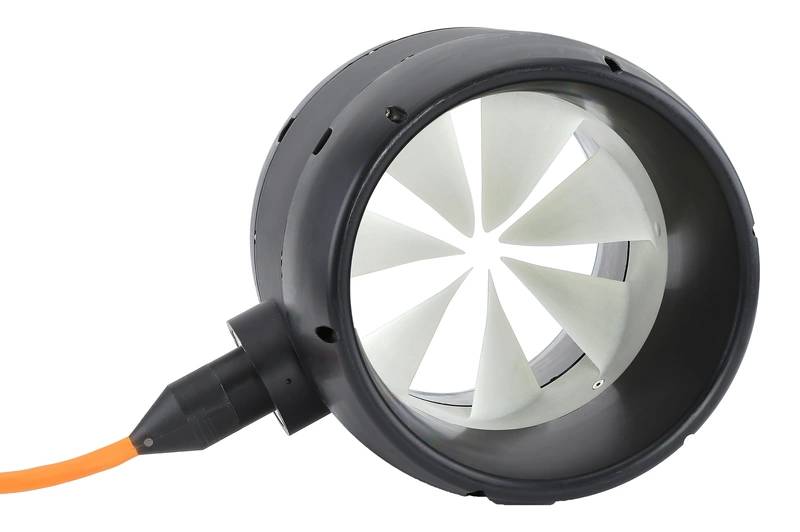 The Gorilla ROV is based on Copenhagen Subsea’s Rim-driven thruster, technology which, combined with industrial electronics from Japan’s OMRON, gives a high level of reliability.Image: Copenhagen Subsea
The Gorilla ROV is based on Copenhagen Subsea’s Rim-driven thruster, technology which, combined with industrial electronics from Japan’s OMRON, gives a high level of reliability.Image: Copenhagen SubseaBy contrast, the Gorilla’s DP system makes it easy to operate the vehicle even in low visibility and strong currents. This is based on an advanced sensor system, which delivers input to the DP system to constantly adjust output of the ROV’s eight thrusters in a fly-by-wire system to keep it stable in the water. The Gorilla can sense the seafloor from up to 70 meters above, enabling the DP system to keep it in the required position, even should the operator take hands off the controls. This solves another common problem during launch of conventional ROVs, when the current can quickly push it away from the vessel, leaving the operator disoriented and without knowledge of its exact location or where to steer to reach its destination. This can often lead to an abandoned mission, necessitating a second attempt or a wait for conditions to improve. Instead, the Gorilla will use its DP system to instantly adjust the output of its eight thrusters to maintain position relative to the seabed, meaning the operator can easily steer to the designated destination. Copenhagen Subsea said the ROV can carry up to 70 kg and it has an easy to understand payload interface with a power supply and separate fiber cable connection, dedicated to the customer specific requirement.
The electrical system of the Gorilla ROV is based on industrial hardware from Japanese industrial electronics company OMRON, meaning that top to bottom Gorilla uses only industrial standard hardware components which are available commercially, a key differentiating factor in the reliability of the Gorilla. Industrial hardware components are cheaper, more reliable and easier to maintain as they are produced in series of hundreds of thousands and deployed worldwide across multiple industries. Such standard components are readily available off-the-shelf anywhere in the world and with significantly shorter delivery times for spare parts, compared to regular waits of 12 weeks or more for proprietary parts from conventional ROV manufacturers. Customers will have access to all electric documentation in the form of wiring diagrams, meaning they can service and maintain the vehicle on their own, as well as a full component list so they can source all parts directly. It means an operating company can simply change the Gorilla’s standard spare parts itself.
These robust industrial components are generally larger, but this means they have the required dimensions to perform reliably in extreme offshore conditions with extended temperature range. These parts also have the capacity to handle overload currents during acceleration and deacceleration and fast shifts of rotational direction. These elements are crucial to keep an ROV stable in challenging offshore conditions. Ideally suited for any task in short, the Gorilla is tough and strong, works reliably in challenging conditions, is simple to maintain with easy access spare parts and is easily controlled thanks to Copenhagen Subsea’s thruster technology.
www.copenhagensubsea.comRead the Full Story in the March 2020 edition of Marine Tchnology Reporter: https://magazines.marinelink.com/nwm/MarineTechnology/202003/#page/52
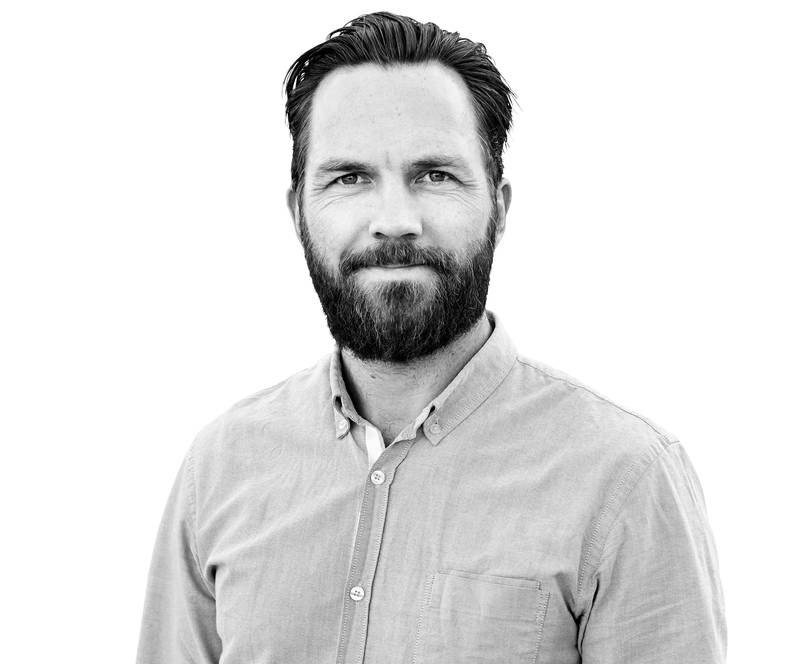 Allan Nygaard Bertelsen, CEO in Copenhagen Subsea
Allan Nygaard Bertelsen, CEO in Copenhagen Subsea -
- New Player in the Rim Thruster Market Marine News, Mar 2015 #56
Rim-driven thruster technology has emerged and demonstrated potential for compact and super-silent maneuvering propulsion. Silentdynamics customized rim-thruster-based propulsion solutions applications include tunnel thrusters, and Silentdynamics ERT thrusters can be configured to be retractable and/or
-
- Z-Drive Towboats Marine News, Oct 2014 #40
organization to a level where it was capable to serve clients globally. ZF turned out to be a perfect partner. ZF Group was looking to add marine thruster technology to its ZF Marine family of products, and it already had the established network of sales and service in place, as well as the engineering horsepower
-
- ZF Marine Makes a Strong Towboat Thrust Maritime Reporter, Aug 2014 #62
a perfect partner. ZF Group, an industrial behemoth with $22.4 billion in sales and 72,643 employees at the end of 2013, was looking to add marine thruster technology to its ZF Marine family of products, and it already had the established network of sales and service in place, as well as the engineering horsepower
-
- Advanced Bow Thruster Efficiency Aided By Stator Screen From Shipwrights Maritime Reporter, Nov 1991 #132
efficiency and power in bow thrusters. Harnessing the power from the water moved by the thruster's twin props is an advancement in bow thruster technology, now exclusive to the Twin Prop system manufactured by Shipwrights, Inc. of Framingham, Mass. Most screens only keep potentially damaging
-
- Finnish Innovation Ascends New Heights Maritime Reporter, Feb 2000 #50
from the Finnish maritime cluster of shipbuilders, marine equipment suppliers and technology innovators. The Finns, with a long track record in thruster technology, were the leaders in the podded drive concept, first applied in the form of a 1.5-MW Azipod unit to a Finnish waterway service vessel in
-
- Omnithruster Continues To "Lead The Way" Maritime Reporter, Sep 2000 #52
it in a unique position amongst its competitors. The JT Series, and its smaller sibling the HT Series, continue to "lead the way" in waterjet thruster technology
-
- Tech & Design Solutions for Modern Workboats Maritime Reporter, May 2016 #50
ZF Group, has been helping owners change the design of their fleets and modernize the propulsion systems they’ve been using for 60 years. “Our thruster technology allows customers to look at using smaller engines but gain better performance than some of their older vessels so they can reduce fuel burn
-
- Podded Propulsion Goes Beyond the Cruise Realm Maritime Reporter, Jul 2001 #44
associated with electric pod propulsion give a solid foundation to consideration of the podded options. Building on a long track record in thruster technology, and underscoring a propensity for maritime innovation, the Finns were the leaders in the podded drive concept. The first contractual reference f
-
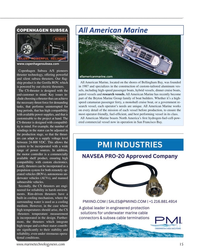 )
September 2024 - Marine Technology Reporter page: 15
)
September 2024 - Marine Technology Reporter page: 15COPENHAGEN SUBSEA All American Marine www.copenhagensubsea.com Copenhagen Subsea A/S pioneers thruster technology, offering powerful allamericanmarine.com and silent subsea thrusters. Our ? ag- All American Marine, located on the shores of Bellingham Bay, was founded ship product is the Gorilla ROV
-
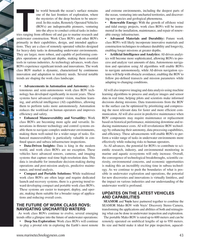 )
January 2024 - Marine Technology Reporter page: 43
)
January 2024 - Marine Technology Reporter page: 43or replacement class ROVs are becoming more agile and versatile. In- based on historical performance, minimizing downtime and re- novations in thruster technology and control systems en- ducing maintenance costs. AI will revolutionize ROV technol- able them to navigate complex underwater environments,
-
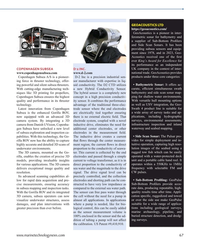 )
September 2023 - Marine Technology Reporter page: 67
)
September 2023 - Marine Technology Reporter page: 67GeoAcoustics provides Copenhagen Subsea A/S is a pioneer- D-2 Inc is a precision industrial sen- products under three core categories: ing force in thruster technology, offer- sor manufacturer with expertise in liq- ing powerful and silent subsea thrusters. uid conductivity. The D2 CTD utilizes • Bathymetric
-
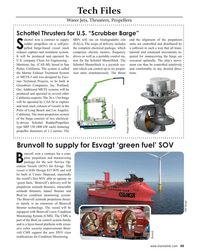 )
June 2022 - Maritime Reporter and Engineering News page: 49
)
June 2022 - Maritime Reporter and Engineering News page: 49thrusters, tunnel thruster and BruCon condition monitoring system. The Brunvoll azimuth propulsion thrust- er family is an extension of Brunvoll thruster technology. The vessel will be HAV Design equipped with Brunvoll’s new Condition Monitoring System (CMS). The CMS is part of the BruCon control system
-
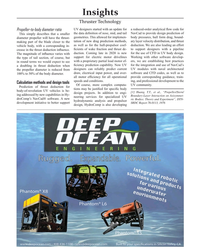 )
September 2020 - Marine Technology Reporter page: 19
)
September 2020 - Marine Technology Reporter page: 19Insights Thruster Technology UV designers started with an update for a reduced-order analytical ? ow code for Propeller-to-body diameter ratio This simply describes that a smaller the data de? nition of nose, mid, and tail NavCad to provide design prediction of geometries. This allowed for implemen-
-
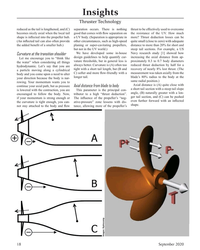 )
September 2020 - Marine Technology Reporter page: 18
)
September 2020 - Marine Technology Reporter page: 18Insights Thruster Technology reduced as the tail is lengthened, and (C) separation occurs. There is nothing thrust to be effectively used to overcome becomes nicely axial when the local tail good that comes with ? ow separation on the resistance of the UV. How much shape is in? ected into the
-
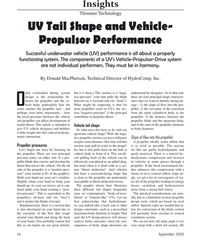 )
September 2020 - Marine Technology Reporter page: 16
)
September 2020 - Marine Technology Reporter page: 16Insights Thruster Technology UV Tail Shape and Vehicle- Propulsor Performance Successful underwater vehicle (UV) performance is all about a properly functioning system. The components of a UV’s Vehicle-Propulsor-Drive system are not individual performers. They must be in harmony. By Donald MacPherson
-
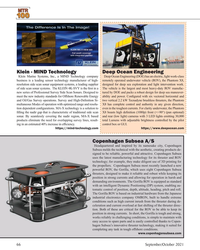 )
September 2021 - Marine Technology Reporter page: 66
)
September 2021 - Marine Technology Reporter page: 66challenging conditions, is simple to maintain with easy access to spare parts and is easily controlled thanks to Copen- hagen Subsea’s innovative thruster technology, making it suited for completing any task in tough offshore conditions. www.copenhagensubsea.com 66 September/October 2021 MTR #7 (66-79)
-
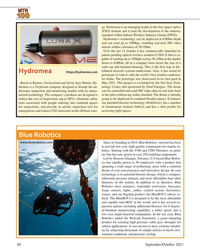 )
September 2021 - Marine Technology Reporter page: 30
)
September 2021 - Marine Technology Reporter page: 30safety going to be deployed in con? ned ? ooded spaces. It features risks associated with people entering into con? ned spaces our patented thruster technology (DiskDrive), has a number for inspections, and provide an ad-hoc inspection tool for of autonomous features built-in and has a slim pro?
-
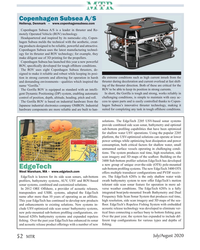 )
July 2020 - Marine Technology Reporter page: 52
)
July 2020 - Marine Technology Reporter page: 52cess to spare parts and is easily controlled thanks to Copen- Japanese industrial electronics company OMRON. Industrial hagen Subsea’s innovative thruster technology, making it hardware components are more reliable and are built to han- suited for completing any task in tough offshore conditions. solutions
-
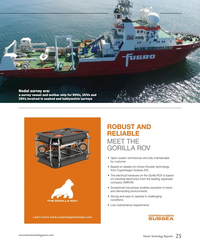 )
May 2020 - Marine Technology Reporter page: 25
)
May 2020 - Marine Technology Reporter page: 25AND RELIABLE MEET THE GORILLA ROV • Open system architecture and fully maintainable by customer • Based on reliable rim-driven thruster technology from Copenhagen Subsea A/S • The electrical hardware on the Gorilla ROV is based on industrial electronics from the leading Japanese company
-
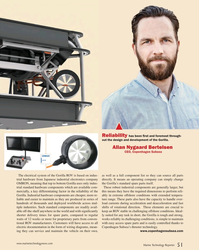 )
March 2020 - Marine Technology Reporter page: 51
)
March 2020 - Marine Technology Reporter page: 51with easy access spare parts and is easily controlled thanks to electric documentation in the form of wiring diagrams, mean- Copenhagen Subsea’s thruster technology. ing they can service and maintain the vehicle on their own, www.copenhagensubsea.com www.marinetechnologynews.com Marine Technology Reporter
-
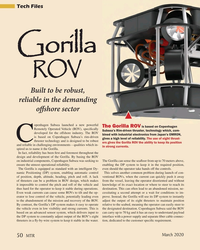 )
March 2020 - Marine Technology Reporter page: 50
)
March 2020 - Marine Technology Reporter page: 50industrial electronics from Japan’s OMRON, is based on Copenhagen Subsea’s rim-driven gives a high level of reliability. The use of eight thrust- Cthruster technology and is designed to be robust ers gives the Gorilla ROV the ability to keep its position and reliable in challenging environments – qualities
-
 )
October 2019 - Marine Technology Reporter page: 57
)
October 2019 - Marine Technology Reporter page: 57Roger Revelle is currently going through an extensive mid-life re? t. One of the upgrades to the vessel is the installation of tele- scoping thruster technology from ZF Marine. The vessel is owned by the US Navy and operated by the Scripps Institute of Oceanography under a char- ter agreement with
-
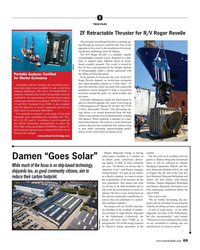 )
October 2019 - Maritime Reporter and Engineering News page: 69
)
October 2019 - Maritime Reporter and Engineering News page: 69Roger Revelle is currently go- ing through an extensive mid-life re? t. One of the upgrades to the vessel is the installation of telescop- ing thruster technology from ZF Marine. The R/V Roger Revelle is a globally capable oceanographic research vessel, designed as a plat- form to support many different
-
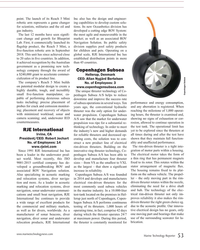 )
July 2019 - Marine Technology Reporter page: 53
)
July 2019 - Marine Technology Reporter page: 53Mini builds No. of Employees: 3 on patented modular design to create a www.copenhagensubsea.com highly durable, tough, and incredibly The unique thruster technology of Co- Copenhagen Subsea small ? ve-function manipulator, ca- penhagen Subsea A/S helps to reduce pable of performing dexterous subsea downtime
-
 )
September 2019 - Marine Technology Reporter page: 50
)
September 2019 - Marine Technology Reporter page: 50a special geared version of its thruster that is now in use on the WHOI Mesobot project. www.bluerobotics.com Copenhagen Subsea A/S The unique thruster technology of Copenhagen Subsea A/S is designed to help reduce downtime and improve the success rate of subsea operations. Copenhagen Subsea A/S saw
-
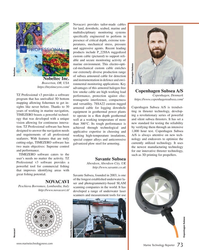 )
July 2017 - Marine Technology Reporter page: 73
)
July 2017 - Marine Technology Reporter page: 73cable for logging downhole Copenhagen Subsea A/S is trendset- years of working in marine navigation, equipment in geothermal power plants ting in thruster technology, develop- TIMEZERO boasts a powerful technol- ing a revolutionary series of powerful to operate in a 4km depth geothermal ogy that was developed
-
 )
May 2016 - Maritime Reporter and Engineering News page: 52
)
May 2016 - Maritime Reporter and Engineering News page: 52ZF Group, has been helping owners change the design of their ? eets and modernize the propulsion systems they’ve been using for 60 years. “Our thruster technology allows cus- tomers to look at using smaller engines but gain better performance than some of their older vessels so they can reduce fuel
-
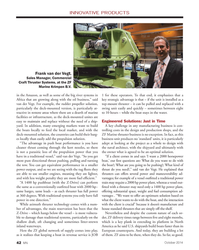 )
October 2014 - Marine News page: 42
)
October 2014 - Marine News page: 42same loads – as each thruster has full power at 360 degrees. With traditional systems you only have full power in one direction.” While azimuth thruster technology comes with a num- ber of advantages, the main reservation has been that the Z-Drive – which hangs below the vessel – is more vulnera- ble
-
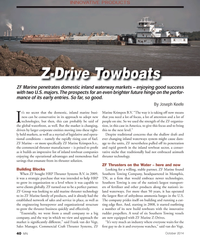 )
October 2014 - Marine News page: 40
)
October 2014 - Marine News page: 40to a level where it was capable to serve clients globally. ZF turned out to be a perfect partner. ZF Group was looking to add marine thruster technology to its ZF Marine family of products, and it already had the established network of sales and service in place, as well as the engineering
-
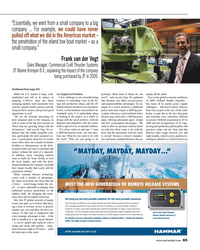 )
August 2014 - Maritime Reporter and Engineering News page: 65
)
August 2014 - Maritime Reporter and Engineering News page: 65market, and with the deck-mounted solution the countries can build their barges locally than easily add the propulsion solution.?While azimuth thruster technology comes with a number of advantages, the main reservation has been that the Z-Drive ? which hangs below the ves-sel ? is more vulnerable to damage
-
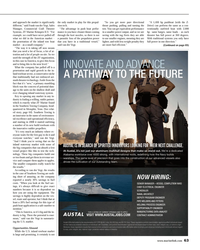 )
August 2014 - Maritime Reporter and Engineering News page: 63
)
August 2014 - Maritime Reporter and Engineering News page: 63has pulled off is a penetration and rapid growth in the in-land towboat sector, a conservative niche that traditionally had not embraced azi-muth thruster technology. Aside from the fact that it?s ?new,? a primary stumbling block was the concern of potential dam-age to the units on the shallow draft and
-
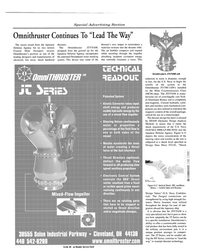 )
September 2000 - Maritime Reporter and Engineering News page: 54
)
September 2000 - Maritime Reporter and Engineering News page: 54in a unique position amongst its competi- tors. The JT Series, and its smaller sib- ling the HT Series, continue to "lead the way" in waterjet thruster technology. /V r A JL m m —» • V, , m* » » » Mixed-Flow Impeller lECHliCAL 3EADOUi Patented System Kinetic Converter takes inpiit shaft
